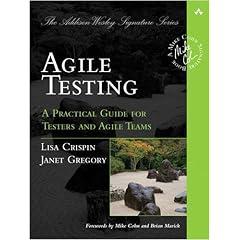
It has been a while since I published a book review on this blog, not because I stopped reading but because none of the books that I read meanwhile really stood out. I’m glad to say that Agile Testing by Lisa Crispin and Janet Gregory finally breaks that trend – it is truly a great book and definitely a must read for anyone serious about quality in agile projects.
The main theme of this book is fitting testing tasks into agile projects, and as such this book really is long overdue. Most agile books are written by programmers for programmers, leaving testers in particular to fend for themselves. No wonder why so many of them feel lost in this world. This book definitely delivers on the promise to ease the transition for testers and QA engineers who suddenly found themselves on an agile project. It has a testing focus and presents things in a way that testers, coming from more traditional process oriented software projects, should understand. The key pillars of practice on which the content of this book stands are improved communication, the whole team approach, agile testing quadrants and automation, so the book efficiently points traditional testers to new knowledge and ideas that they need to focus on to contribute to an agile project. It also provides a solid framework for executing traditional testing tasks in an agile environment without lagging behind the development and causing the project to fall into the “mini-waterfall” trap.
I would also recommend it to project managers and team leaders as they will be able to see the project from the testers’ eyes and complement their knowledge about quality on agile projects. As such, it is especially an important reading for teams that consider JUnit the extent of their “testing” process. The book raises valid concerns about commonly overlooked tasks such as test planning, security, performance and usability testing, documentation testing and provides some very practical advice how to plan and execute exploratory testing efficiently.
The book is around 500 pages long, which is twice the threshold for the books I typically like to read, so it is quite heavy and not easy to carry around and read while you are on your way to work - which is a real shame. Nevertheless, it reads very easily and justifies the thickness with lots of interesting content throughout the book, staying away from any abstract academic discussions. The book is filled with practical advice and experience reports from real world projects and stories from various teams, which I found particularly interesting. For me, the key take-away is probably chapter 12, which provides a testers view at a realistic project from start to end, including tools and strategies used from the requirements to the delivery. It was really interesting to read a different take on the subjects that I often write about, especially the specification workshops (the authors call them “power of three”).
Pick up the book now from Amazon.com


